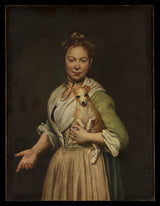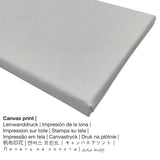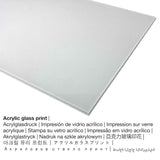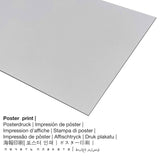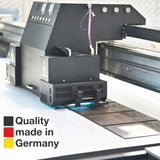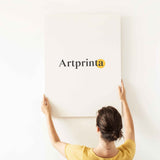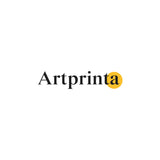Giacomo Ceruti, 1740 - Nwanyị nwere Nkịta - mbipụta nka mara mma
Ụtụ gụnyere. Mbupu gbakọrọ na ndenye ọpụpụ.
What does the original artwork description of the The Metropolitan Museum of Art write about this work of art created by Giacomo Ceruti? (© - Ụlọ ihe ngosi nka nke obodo ukwu - Museumlọ ihe ngosi nka nke Obodo)
Giacomo Ceruti, nicknamed "Pitocchetto" (the little beggar), is still an enigmatic personality. His fame rests upon his numerous portraits and genre paintings. As his sobriquet implies, these often portray figures from the lower classes and seem to have enjoyed a widespread popularity among amateurs throughout northern Italy. Our painting is typical both in the social class of the subject, probably a maidservant carrying her mistress's dog, and its direct, unidealized presentation.
Ozi gbasara ngwaahịa nka a
In 1740 Giacomo Ceruti tee ihe a 18th narị afọ artwork. The masterpiece was made with the size: 38 x 28 1/2 in (96,5 x 72,4 cm) and was painted on the medium mmanụ na kwaaji. Taa, ọrụ nkà a nwere ike na-ele na nchịkọta nke Museumlọ ihe ngosi nka nke Obodo in New York City, New York, Njikota Obodo Amerika. The nka ochie artpiece, nke dị na ngalaba ọha a na-enye ya site n'ikike nke Ụlọ ihe ngosi nka nke Metropolitan, New York, Maria DeWitt Jesup Fund, 1930. Ọzọkwa, ihe nkiri ahụ nwere kreditline ndị a: Maria DeWitt Jesup Fund, 1930. E wezụga nke a, nhazi nke mmepụta dijitalụ bụ Eserese na nwere akụkụ ruru nke 3: 4, nke pụtara na ogologo bụ 25% mkpụmkpụ karịa obosara. The painter Giacomo Ceruti was a European artist, whose artistic style was primarily Baroque. The artist was born in 1698 in Milan, Milano province, Lombardy, Italy and passed away at the age of 69 in 1767.
Kedu ihe ebipụta nka kacha amasị gị?
Maka ngwaahịa ọ bụla anyị na-enye nha na ihe dị iche iche. Nhọrọ ndị a dị maka n'otu n'otu:
- Mbipụta akwụkwọ mmado (akwa akwa akwa): A poster is a UV printed cotton canvas with a slightly roughened surface structure. Please note, that depending on the absolute size of the poster we add a white margin of something between 2-6cm round about the print to facilitate the framing with your custom frame.
- Mbipụta enyo acrylic: A glossy print on acrylic glass, often referenced as a plexiglass print, makes the artwork into beautiful décor. The major advantage of an acrylic glass fine art print is that contrasts plus painting details will be more identifiable with the help of the precise gradation in the picture.
- Aluminom dibond (ọkpụkpụ ọla): Aluminium Dibond prints are metal prints with a true depth effect. A non-reflective surface structure make a fashionable look. A direct Direct Print on Aluminum Dibond is the perfect introduction to prints made with aluminum. The white and bright components of the artwork shine with a silk gloss, however without the glow. The colors of the print are luminous in the highest definition, the details of the print appear crisp and clear.
- Mbipụta kwaaji: The canvas print is a printed cotton canvas mounted on a wooden stretcher. Hanging a canvas print: Canvas prints are relatively low in weight, which means that it is easy to hang up your Canvas print without additional wall-mounts. Because of thatcanvas prints are suited for all types of walls.
Nchịkọta dị mkpirikpi nke onye na-ese ihe
| Aha onye nka: | Giacomo Ceruti |
| Aha ndị ọzọ: | Il Pitocchetto, Giacomo Antonio Ceruti, jakopo ceruti, Giacomo Ceruti, Giacomo Il Pitocchetto, Ceruti, Pitocchetto Il, Ceruti Giacomo, Pitocchetto, Ceruti Jacopo, Ceruti Jacobus, Pittocchetto Il, Ceruti Giacomo Antonio |
| okike nke onye nka: | nwoke |
| Obodo onye nka: | Italian |
| Ọrụ nke onye na-ese ihe: | onye na-ese ihe |
| Mba onye si: | Italy |
| Otu nka: | nna ukwu ochie |
| styles: | Baroque |
| Ndụ: | 69 afọ |
| Afọ amụrụ: | 1698 |
| Amụrụ na (ebe): | Milan, obodo Milano, Lombardy, Italy |
| Nwuru: | 1767 |
| Obodo ọnwụ: | Milan, obodo Milano, Lombardy, Italy |
Ozi ndabere gbasara mpempe nka
| Aha ọrụ nka: | "Nwanyị nwere Nkịta" |
| Nhazi nka: | sere |
| Otu izugbe: | nka ochie |
| Time: | 18th narị afọ |
| Emepụtara n'afọ: | 1740 |
| Ogologo afọ nka nka: | ihe dị ka afọ 280 |
| Usoro nka izizi: | mmanụ na kwaaji |
| Ogo nke ọrụ nka izizi: | 38 x 28 1/2 na (96,5 x 72,4 cm) |
| Egosiputara na: | Museumlọ ihe ngosi nka nke Obodo |
| Ebe ngosi nka: | New York City, New York, Njikota Obodo Amerika |
| Weebụsaịtị ihe ngosi nka: | Museumlọ ihe ngosi nka nke Obodo |
| Akwụkwọ ikike nka: | ngalaba ọha |
| Site n'aka: | Ụlọ ihe ngosi nka nke Metropolitan, New York, Maria DeWitt Jesup Fund, 1930 |
| Ebe kredit nke ọrụ nka: | Maria DeWitt Jesup Fund, 1930 |
Banyere edemede a
| Nkewa ngwaahịa: | nka nka |
| Usoro mmeghari: | dijitalụ mmeputakwa |
| Usoro nhazi: | mbipụta dijitalụ |
| Mmalite ngwaahịa: | German mmepụta |
| Ụdị ngwaahịa: | na mmepụta ihe |
| A na-atụ aro iji ngwaahịa eme ihe: | mgbidi gallery, ụlọ ihe ngosi nka |
| Nhazi onyonyo: | nhazi ihe osise |
| Oke akụkụ onyonyo: | ( Ogologo: obosara) 3: 4 |
| Akụkụ akụkụ pụtara: | ogologo bụ 25% mkpụmkpụ karịa obosara |
| Ụdị ihe dị iche iche dị: | acrylic glass print (nwere ezigbo mkpuchi iko), mbipụta akwụkwọ mmado (akwụkwọ kwaaji), mbipụta kanvas, mbipụta ọla (aluminium dibond) |
| Nhọrọ nha nke akwa akwa n'elu etiti ihe na-agbatị (mbipụta kwaaji): | 30x40cm - 12x16", 60x80cm - 24x31", 90x120cm - 35x47", 120x160cm - 47x63" |
| Mbipụta iko acrylic (nwere ezigbo mkpuchi iko) dị iche iche: | 30x40cm - 12x16", 60x80cm - 24x31", 90x120cm - 35x47", 120x160cm - 47x63" |
| Mbipụta akwụkwọ mmado (akwụkwọ kwaaji): | 30x40cm - 12x16", 60x80cm - 24x31", 90x120cm - 35x47" |
| Mbipụta aluminom: | 30x40cm - 12x16", 60x80cm - 24x31", 90x120cm - 35x47" |
| Nhazi mbipụta nka: | biko buru n'uche na mbiputa nka enweghi okpokolo agba |
Nkwupụta iwu: We do what we can to describe the products as accurate as possible and to illustrate them visually on the product detail pages. However, the pigments of the printing material, as well as the imprint might differ slightly from the image on your device's screen. Depending on the settings of your screen and the quality of the surface, not all color pigments will be printed one hundret percent realistically. In view of the fact that our are processed and printed by hand, there might as well be minor variations in the size and exact position of the motif.
Copyright right, Artprinta.com (Artprinta)

